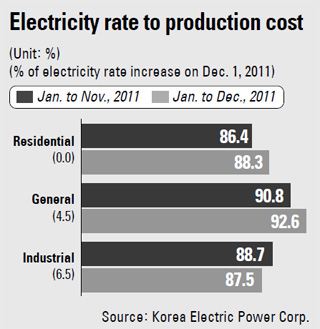Kepco hike in electricity rates draws corporate ire

On Dec. 1, 2011, the Ministry of Knowledge Economy, which heads the government’s 51 percent stake in the nation’s largest electric utility company, announced a hike in prices for industrial use, citing a rise in production costs and the accumulation of losses, which reached 8 trillion won ($7 billion).
But despite the rate increase, the ratio of electricity rates to production costs remains at 87.4 percent. A ratio under 100 percent means the company is still incurring losses.
“Kepco’s ratio of electricity rates to production costs increased for residential use, though it did not raise residential rates,” said Yun Won-cheol, a finance professor at Hanyang University. “But the ratio fell for industrial usage though the electricity price was raised.”
Kepco has stated that electricity rates are so low that it cannot cover its operation costs. The company recently suggested that the government needs to raise electricity prices by an average of 13.1 percent.
According to Kepco, its ratio of electricity rates to production costs from January to November for residential use was 86.4 percent. For general use (such as offices and commercial buildings) it was 90.8 percent and for industrial use it stood at 88.7 percent.
The business community points out that even though Kepco raised industrial rates, its ratio of electricity rates to production costs for industrial use from January through December declined by 1.2 percentage points to 87.5 percent.
However, residential use improved by 1.9 percentage points to 88.3 percent.
“Whether it is industrial use or residential use, production cost is the same,” Yun said. “But the ratio improved for residential use though electricity rates remained the same while the ratio worsened for industrial use, which had a rate increase.”
“The change in the ratio is because electricity rates vary according to the amount of usage. That is why there are differences in the ratio of electricity rate to production cost,” said Lee Dong-seung, a senior spokesman at Kepco.
By Moon Byung-joo [jbiz91@joongang.co.kr]










with the Korea JoongAng Daily
To write comments, please log in to one of the accounts.
Standards Board Policy (0/250자)